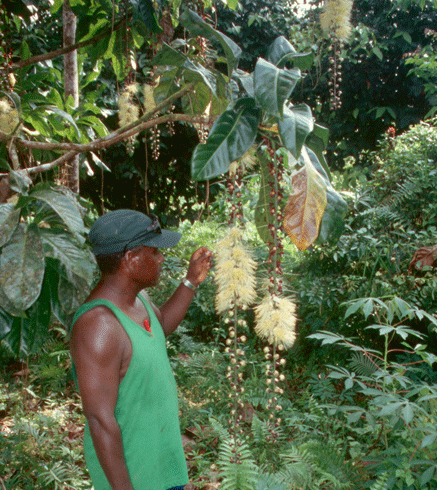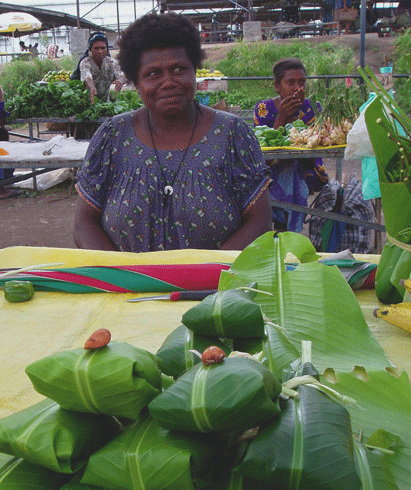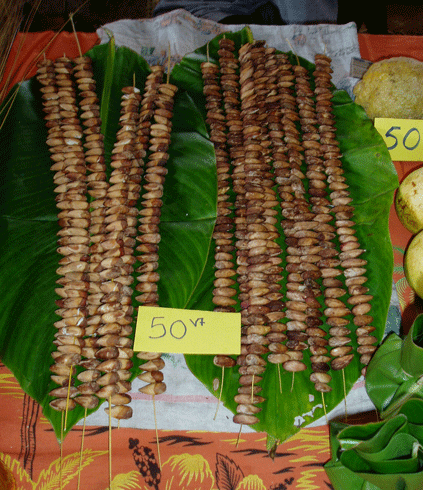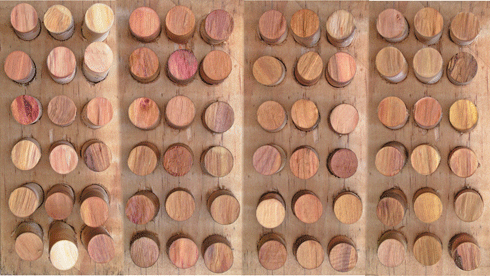
|
Published: 15 october 2012
'Low hanging fruit' to enrich the tropics
Many tropical tree species largely ignored by modern agriculture could, if domesticated, form the basis of integrated rural development in the tropics, says agroforestry expert Professor Roger Leakey. Prof. Leakey says these trees have the potential to alleviate poverty, hunger and malnutrition while also countering environmental degradation and climate change.

|
|
Dr Richard Pauku examines the flowers of Barringtonia procera (cutnut) in the Solomon Islands. Credit: Roger Leakey
|
To many people, trees are just big green plants that vary in shape and size and produce useful things – such as timber, rubber and apples – some of which come from tropical forests that are being destroyed, creating environmental problems.
Some people recognise that trees protect hillsides and watersheds from erosion, ensuring that clean water supplies are maintained and that rivers don’t flood towns and silt up dams.
Media attention to climate change has also alerted people to the importance of trees and forests as carbon stores to lessen climate change. Likewise, the media has done a good job of explaining the role of trees and forests in the protection of wildlife – even if the focus has tended to be on colourful plants and birds, cuddly creatures and fierce predators.
Trees play an even more critical role in the ecology of our habitat. By providing a perennial three-dimensional structure, trees create a forest with a host of ecological niches and a range of microclimates above and belowground.
Each of the plants and animals that colonise these niches has its own complex food chain and lifecycle, which diversifies the ecosystem. Through their lives and deaths, forest inhabitants recycle nutrients and water and engage in the ecological balancing trick that maintains ecosystem health and resilience. These are the functions that lead to ecological sustainability.
Many millions, if not billions, of people depend on the world’s dwindling resource of trees as a source of nutritious foods, medicines and other products of everyday importance. These people live mostly in tropical and sub-tropical countries, where their dependence on such tree products is largely ignored by policy makers and agricultural experts developing plans for the future of agriculture.
Our growing human population and need for food is the reason why billions of people are hungry and malnourished. Modern tropical agriculture wastes the natural resource of useful forest species, clearing the trees and damaging the environment.
While the Green Revolution hugely increased the potential yield and quality of the modern varieties of key staple food crops, billions of farmers throughout the tropics cannot grow such crops at anywhere near their potential. The reasons are complex, but can be boiled down to a failure to implement farming systems that maintain soil fertility and maintain the ecological health of the land. As a consequence, degraded farmland is abandoned; those farmers who can’t move on are left struggling to feed their families even a very basic diet.

|
|
A stallholder sells canarium nuts in New Britain, Papua New Guinea. Credit: Roger Leakey
|
Many of us living in industrialised countries don’t realise how many useful tree species are found in the tropics. But a glance at a book about tropical trees quickly illustrates that almost every species has at least one useful purpose beyond providing cooking fuel, building materials and timber. Most of these uses relate to health and nutrition.
Take the galip nut (Canarium indicum) from Papua New Guinea, the Solomon Islands and Vanuatu. It was so important to everyday life for thousands of years that its edible nuts became an early form of currency.
Galip nuts are mainly eaten raw, but can be cooked and also preserved by smoking or drying; the tasty kernels are oil rich and highly nutritious. The kernel oil has anti-inflammatory properties recognised in traditional knowledge as a treatment for arthritis. The wood has many uses, from canoe making to house construction, and is also carved into sculptures. In traditional medicine, the bark is used to treat vomiting, while the leaves are used to treat scabies and ciguatera (a foodborne illness caused by eating certain reef fish). This list of uses for a single tree species is by no means exceptional.

|
|
Canarium nuts for sale in Port Vila market, Vanuatu. Credit: Roger Leakey
|
In 1992, modern agriculture’s rejection of these traditionally important tree species was recognised by a conference in Edinburgh that I organised with Dr Adrian Newton. Out of that meeting came a global research initiative to domesticate some of these species as new cash crops for poor, smallholder farmers in the tropics. The initiative was led by the International Centre for Research in Agroforestry (now known as the World Agroforestry Centre), of which I was Director of Research from 1993–1997. Other research teams, including the Agroforestry and Novel Crops Unit of James Cook University (JCU) in Cairns, have since come on board.
Today, about 50 of these tree species are being domesticated as new crops to improve the livelihoods of poor people, providing nutritious and tasty dietary additives to otherwise starch-heavy diets based on maize, cassava, yams and plantains.
Because there are still active local markets for the tree products, the cultivation of these species is now also generating income and transforming the lives of marginalised rural communities, especially in Africa. The story behind this global initiative has recently been published in my book Living with the Trees of Life – Towards the Transformation of Tropical Agriculture.
During my time with JCU, the Agroforestry and Novel Crops Unit has initiated tree domestication projects in the Pacific region: cutnut (Barringtonia procera) and Tahitian chestnut (Inocarpus fagifer) in the Solomon Islands, galip nut in Papua New Guinea, and sandalwood (Santalum austrocaledonicum in Vanuatu, and S. lanceolatum in Cape York, Queensland).We also explored the potential of ‘bush tucker’ plants in Australia.
As had been found earlier in relation to indigenous fruits and nuts in Africa (Dacryodes edulis or safou, Irvingia gabonensis or bush mango, and Sclerocarya birrea or marula), the Pacific species showed 3 to 5-fold tree-to-tree variation in fruit/nut/kernel morphology. The variation was continuous, showing no indication of any distinct varieties in the wild population.
Such large variation provides great potential to develop cultivars using simple horticultural techniques such as the rooting of cuttings, grafting and marcotting (marcotting is a technique of promoting root development by wounding the part of the plant to be rooted with roots induced to form on the plant stem).
Interestingly, molecular studies of these tree populations have shown that the trees with superior qualities are not closely related. So, the risk of reducing genetic diversity – for example, through tree domestication programs in different villages – is unlikely to be significant.
In Africa, the World Agroforestry Centre has adopted a participatory approach to tree domestication with rural communities, aiming to make the communities instant beneficiaries of the research. The key strategy is to ensure that the techniques can be adopted at the village level: to produce planting stock for local farmers, and improved fruit and nut products with above-average quality and greater uniformity for local marketing.
Dr Richard Pauku is developing a similar approach in the Pacific, especially in the Solomon Islands. Again, as in Africa, domestication of indigenous tree species has started new business and employment opportunities for rural communities in the processing, value-adding and wider trade of tree products. This is an excellent example of diversified and more sustainable tropical agriculture, and of integrated rural development – a model that, with up-scaling, could alleviate poverty, hunger and malnutrition while also countering environmental degradation and climate change.
More detailed studies in Africa and in Papua New Guinea have also demonstrated conclusively that tree-to-tree variation in fruits and nuts is not restricted to their morphology (i.e. shape, size, colour): it extends to their taste, oil content, food-thickening properties, medicinal properties and nutritional quality. Thus, the potential to develop new commercial products in the food, pharmaceutical, nutriceutical and cosmetic industries is significant.
Globally, multinational companies are beginning to recognise market opportunities by partnering with communities in tropical countries. This new business paradigm has huge potential to change the fortunes of these poor and vulnerable people, who have historically been marginalised by the way in which globalised trade and industry operates.
The sandalwood project at JCU was designed to investigate the extent to which S. austrocaledonicum and S. lanceolatum had domestication potential similar to that of Indian sandalwood (S. album), the species used in the perfume industry.
The potential was found to be as great, if not greater than, S. album and, while the average quality of the essential oils in the heartwood of the individual species did not reach the standards of the international perfume industry, there were again individual trees with very high-quality oils. This tree-to-tree variation in essential oil quality was unrelated to heartwood colour, which is a common determinant of sandalwood price, and seemed to be independent of the host species of this parasitic tree.

|
|
Tree-to-tree variation in the colour of sandalwood (S. austrocaledonicum) heartwood cores from Vanuatu. While the colour was found to be unrelated to the essential oil quality, there was a weak relationship with oil yield.1 Credit: Roger Leakey
|
In Cameroon, local people are also starting to process products from tropical trees, making it possible to sell these products further afield, as well as ‘out-of-season’. Value-adding in this way is also starting to create employment and business opportunities, which further adds to the income-generating opportunities for local people.
This agroforestry approach also has important environmental benefits. Trees protect and enrich soils and watersheds; promote animal life all along the food chain, from microbes to top predators; sequester carbon to mitigate climate change; and add resilience to our ecosystems – especially our agroecosystems.
These are benefits that the world needs in abundance if we are to protect our environment and overcome the scourge of poverty, malnutrition and hunger. Support for tree domestication is urgently needed to scale up these efforts to a meaningful level.
Roger Leakey is Adjunct Professor in the School of Marine and Tropical Biology, James Cook University, Cairns, Queensland, and was head of research at the International Centre for Research in Agroforestry (now the World Agroforestry Centre), from 1993–1997.
1 Page T, Southwell I, Russell M, Tate H, Tungon J, Sam C, Dickinson G, Robson K and Leakey RRB (2010) Geographic and phenotypic variation in heartwood and essential oil characters in natural populations of Santalum austrocaledonicum in Vanuatu. Chem. Biodivers. 7, 1990–2006.



